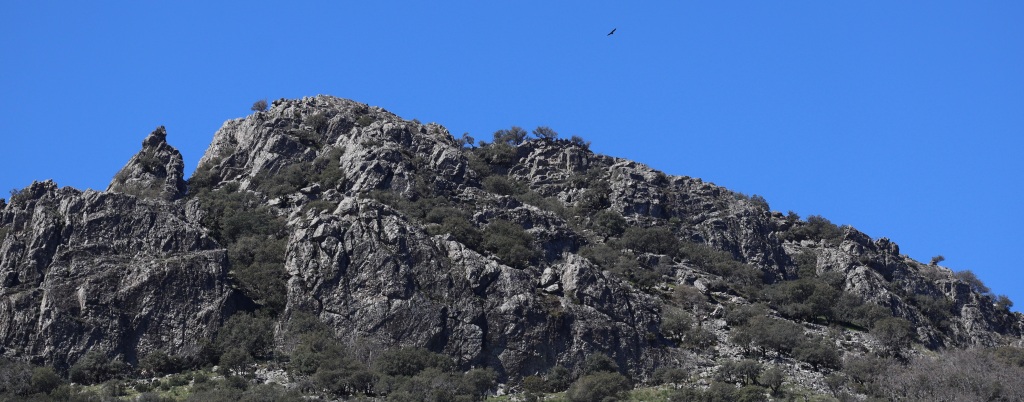
There are painted shapes in the rocks at Monfragüe, and the faintest ancient smears of human touch. But they’re hardly on display for public edification – you have to clamber up the desperate, jagged cliffs, following a zig-zag track to the foot of a rupture in the rock where the vultures are nesting. Some of these ungodly birds have young at this time of year – you can hear them chattering like goblins in the rootstock, and as the adults glide and turn above the plains, their soot-black shadows fall in arcs to the cork oak trees and the tumble of scree.
In recent years, some bright spark has built a metal staircase at the foot of the final ascent, but it would have been a hard and steady pull to this place in the ancient times. It’s no wonder the paintings were lost for thousands of years, and only surprising they were ever found again – because even when you reach the giddy heights of the cavetop roof with a forty mile span of Spain behind you, the paintings are almost invisible to the naked eye. They have to be shown and deliberately thrown into relief with card and sheets of paper. So you find yourself frowning at the long-forgotten smudges, making out the horns of an aurochs or the belly-bright patterns of eyemarks and fingertip dots in indecipherable morse. There’s almost nothing there, and yet “almost” is working hard in the sweat-stained shade.
In the clearest panel of painting, there’s a stag grazing and a red man imposed upon it. Three thousand years lie between the stag and the man, but sometimes the newer marks are fainter than the old ones, and it all depends on how the iron oxide was mixed with fat or oil and whether it was summer or winter when the paintings were made. Various factors determine the absorbency of the stone and the subsequent durability of the mark, and when you lower your face for the closest look, it’s seems as though these simple, original gestures have caused the rock to welt and rise like allergies. The colour is inside the stone like tattoo ink, and if this artwork was as easy to remove as chalk from a blackboard, it would have vanished thousands of years ago. Whoever made these marks can hardly have known that they would last forever, but it’s hard to think of a modern technique that would endure with more persistence.
In the most recent tranche of markings which date to a thousand years before Christ, there’s a tendency towards a particular figure. The same man crops up in four or five different paintings, always wearing a spiked headdress. Sometimes the spikes are round and flossy as feathers – elsewhere they’re jagged and insistent, threatening outwards like tongues of flame from a sun. The figure is opaque and unsmiling, and he’s staring directly out of those rocks like a man interrupted. Specialists believe he is a chief or a shaman, and my guide described him as “the boss”. But knowing only part of the story is worse than knowing nothing at all, and whatever he signifies is gone – only the nightmare remains in a sudden start of recognition. Because I’ve seen him before, and I didn’t like him then.
It was my impulse to say “Hello Stranger”, but I shrank to find that in speaking, I’d spoken correctly. And suddenly I was reversed into that same moment of panic when you rise up from sleep to the sound of something stalking in the rip of a downturned moon. And I didn’t want him near me then, but I was the only one who could leave. There were ripples of chilling in the cavetop, and if the tour guide was talking, I couldn’t hear him.
Several hundred feet above the cave, the stump of an ancient castle stands as something of a minor tourist attraction. There have been so many wars and blood spilled in the landscape of Extremadura that this lookout has looked out for danger in every direction over the years. And it doesn’t matter if the ramparts were manned by Moors or Christians or British redcoats – they pale by comparison to “the boss” below who saw it all coming and laughed at the idea that any one of us will be remembered in the end.
Even within earshot of the castle walls, carrion feeders are shitting out the scalded flesh of fallen creatures; the sprays are made in gouts of white emulsion, and if you aren’t afraid in those mountains, you’ve missed the point of the vulture’s beak – because there are things out there which aren’t for us, and in the highest pitch of Iberian contrast, the brightest day is chased by a thumping, tortured night. I looked for something new in Spain, but found instead a heightened form of all the joy and fears I’ve had since birth.
Leave a comment